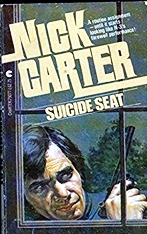REVIEWED BY DAVID VINEYARD:
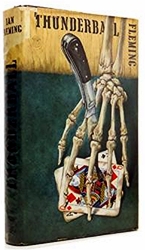
IAN FLEMING – Thunderball. James Bond #9. Jonathan Cape, UK, hardcover, 1961. Viking Press, UK, hardcover, 1961. Signet, US, paperback, 1962. Reprinted many times, in both hardcover and paperback. Filmed as: Thunderball (1965). Sean Connery, Claudine Auger, Adolfo Celi Directed by Terence Young; and as Never Say Never Again (1983). Sean Connery, Kim Bassinger, Klaus Maria Brandauer. Directed by Jack Smight.
“What’s the good of other people’s opinions? Animals don’t consult each other about other animals. They look and sniff and feel. In love and hate, and everything in between, those are the only tests that matter. But people are unsure of their own instincts. They want reassurance. So they ask someone else whether they should like a particular person or not. And as the world loves bad news, they nearly always get a bad answer – or at least a qualified one.â€
The speech above is in response to Domino Vitale, the mistress, or as Ian Fleming has Bond tell us, the “courtesan de marque,†of Emilio Largo, at this point in the novel a “person of interest†in the investigation James Bond and CIA friend Felix Leiter are making as part of a global search for a missing nuclear weapons stolen from NATO, and being used by SPECTRE, a criminal terrorist organization lead by Ernst Stavro Blofied, to extort money from the West’s governments.
Domino’s brother was the pilot of the unfortunate missing NATO flight, enough for Bond and Leiter to be sent to the Bahamas on something of a wild goose chase well away from the hot spots where the real action is centered, and Largo, a wealthy and somewhat piratical figure has both the money and means of hiding the missing nukes.
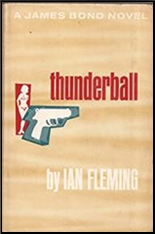
Of course by this point we, the reader already know Largo is an agent of SPECTRE and Blofield, but as yet Bond doesn’t.
Thunderball was the eighth James Bond novel and followed a break after Goldfinger where the new James Bond had been a collection of short stories, For Your Eyes Only.
In fact Thunderball was the result of the author’s dwindling enthusiasm for his creation after a series of bitter disappointments about Bond’s screen fortunes. A proposed Hitchcock film of From Russia With Love had fallen through (Hitchcock ended up doing North by Northwest instead), and while sales for the Bond novels had rocketed with Doctor No and Goldfinger, the television series pilot “Commander Jamaica” that fell through had become the plot of Doctor No, and a short story collection consisted of five stories Fleming wrote as scenarios for a proposed television series, James Bond, Secret Agent, that had fallen through and ended up the hit series Danger Man with Patrick McGoohan, who despised Bond, as secret agent John Drake. Even a Ben Hecht scripted adaptation of Casino Royale had fallen through.
Thunderball itself might not even have seen print if a film director named Kevin McClory hadn’t approached Fleming about an idea for an original story and with screenwriter Jack Whittingham and Fleming written the screenplay that Fleming “novelized†as his James Bond novel for 1961. The legal mess the novels origin created would haunt the film franchise well into the 21rst Century before it was settled to everyone’s satisfaction.
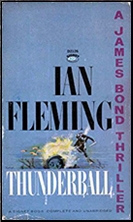
If you are still with me, try to ignore all that history for a minute though, and go back to that paragraph I opened with, because to some extent that paragraph is what I’m really discussing here, not the history of the Bond franchise, but why Ian Fleming deserves to be read still and why there has been both a revival and a reassessment of his work in England.
Even if you hate Bond, despise the idea of a British hero (and I know American fans who never forgave Fleming and Bond for eclipsing the endless supply of American wanna-be Bond replacements who don’t cut it or don’t last), and loathe the film franchise, the fact is that Fleming, careless as he could be, sexist as he and his creation are, men of a different time and sensibility that both are, was actually a damn good writer whose instinct went well beyond what even he admitted.
In the chapter at hand, Bond is already in the Bahamas, and he and Leiter have been aboard Largo’s yacht, the Disco Volante, with a geiger counter seeking signs of the missing nuclear weapons. Bond has decided to get closer to Largo through Domino, and to hopefully, through seduction, to turn her against Largo as his “inside man.â€
Domino, is a typical Fleming heroine, attractive, but not flawless. She may have the “fine firm breasts†even Bondphile Kingsley Amis made fun of in his James Bond Dossier, but like most of Fleming’s women she a “bird with one wing down,†physically marred by one leg shorter than the other, and emotionally tormented by her past and her present.
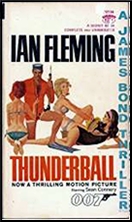
In fact I’ve always thought that quite a few Bond women should have been played by either Gloria Grahame or Lizbeth Scott with their histories of wounds, and insecurities. Contrary to the image of the films they don’t just hop into bed with Bond, and in book after book he finds himself, reluctantly at first because he wants to get on with job and often is shown thinking so rather bluntly, playing psycho-therapist to a succession of abused and emotionally stunted women he rather surprisingly rescues not only from the dragon, but from their own self destructive course.
Bond in the books doesn’t win them over by his dark good looks or his sexual techniques and gifts. Hhe wins them over by being their way of reconnecting to life and normality. His most romantic gift turns out to be treating women well.
Along the way no few of them rescue Bond too, because, also despite the films, Bond usually begins or ends the book in need of physical and emotional rehabilitation. In fact that is where he starts Thunderball, drinking too much, drifting into too many messy affairs, losing his edge (It was one of those days when it seemed to James Bond that all life, as someone put it, was nothing but a heap of six to four against), and thanks to a fussy and newly enthused M (Was this the first sign of senile decay?) sent to a health spa, Shrublands, for a course of drying out (“I’d rather die of drink than thirst.â€), wheat-germ (…foods he had never heard of, such as Potassium Broth, Nut Mince, and the mysteriously named Unmalted Slippery Elm.), and massage.
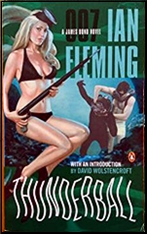
Miss Moneypenny rather neatly skewers him when he threatens to spank her for her amused tone at his dilemma, “I don’t think you’ll be able to do much spanking after living on nuts and lemon juice for two weeks, James.â€
Being Bond, James Bond, 007, he stumbles onto an international plot by SPECTRE and is nearly killed, but not before a nasty turn with health food. He spots Count Lippe whose strange ring catches his eye before his first treatment. Yes, there is a sexy nurse and a mink glove, but this is wish fulfillment. I can’t imagine most readers would rather Nurse Ratchet give him a high colonic instead, at least not rather read about it.
It’s the fact that Fleming doesn’t need to spend a chapter telling us Domino’s life history that makes his choice to do so interesting. He could draw a tough but broken woman with a few lines if he wanted, as most thriller writers would have done, but instead he has Domino bothered by what people think of her as Largo’s expensive sex toy and in need of reassurance from Bond by telling him her backstory, and the key thing is that Bond’s response isn’t some sexist tough guy bull dragged out of the testicular fantasy of some chair bound pretend tough guy but sensitive and even thoughtful.

It really isn’t the response of a Lothario or Don Juan, it’s the thoughtful response of a man who for all his tough self talk likes women. Later there is a tender and sexy scene when he has to bite poisonous sea spines out of her wounded heel (symbolic of the one short leg that mars her beauty, something else Fleming didn’t have to include), and it leads to the first time they have sex and he turns her.
She said, looking seriously up at him, ‘Do you know, you’re the first man who’s ever made me cry.’ She held up her arms and now there was complete surrender.
It pays off as well, because Domino not only helps, she is key to Bond’s success and saves his life in the finale.
And not once does Fleming or Bond speculate that women ought to be raped for wearing pants like a popular American spy novelist.
That it also goes to plot and provides Bond with information he needs about Largo and her brother is where the art lies, but Fleming could have taken more familiar thriller tracks to that same destination. That he doesn’t shows he still had that ambition to write thrillers that could be read not as literature, but with some of the pleasures of literature.
I recognize that last line is what many readers have against Ian Fleming and James Bond in the novels. How dare an entertainer slow down the bang bang and kiss kiss for write write and think think. It always amazes me when critics condemn Fleming, but praise the often prolix and dense le Carre as if being difficult and tiresome to read was a virtue in a thriller writer. I enjoy le Carre, but I’m damned if I can find much worth quoting in his work.

Fleming, however much you hate him, is quotable. His turn of phrase is more than sufficient, it is often eye catching and memorable. Like Raymond Chandler, or Georges Simenon, both of whom he admired, there is often something more to Fleming and Bond than just a wild yarn full of action with a bit of sex thrown in. There are passages of fine writing and even well drawn characters who come to life.
It was really quite disturbing. Was his personality changing? Was he losing his edge, his point, his identity? Was he losing the vices that were so much part of his ruthless, cruel, fundamentally tough character? Who was he in process of becoming? A soft, dreaming, kindly idealist who would naturally leave the Service and become instead a prison visitor, interest himself in youth clubs, march with the H-bomb marchers, eat nut cutlets, try and change the world for the better?
Or:
The jawline, going to the appropriate middle-aged fat of authority, showed decision and independence. Only the mouth, under a heavy, squat nose, marred what might have been the face of a philosopher or a scientist. Proud and thin, like a badly healed wound, the compressed, dark lips, capable only of false, ugly smiles, suggested contempt, tyranny, and cruelty. But to an almost Shakespearian degree. Nothing about Blofeld was small.
Or:
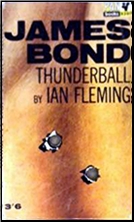
They swam on in the soft moonlit mist of the sea. At first there was nothing but a milky void below them, but then the coral shelf of the island showed up, climbing steeply towards the surface. Sea fans, like small shrouds in the moonlight, waved softly, beckoning, and the clumps and trees of coral were grey and enigmatic. It was because of these things, the harmless underwater mysteries that make the skin crawl on the inexperienced, that Largo had decided to lead the disposal teams himself.
Or:
In front of him Largo, Largo with a spear sticking horribly through his neck, lay kicking feebly on the sand. Behind him and looking down at the body, stood a small, pale figure fitting another spear into an underwater gun. The long hair flowed round her head like a veil in the luminous sea.
If nothing else, his villains, often drawn from life (Largo here is almost a caricature of Aristotle Onassis) raise the stakes considerably. If a thriller is only as good as its villain, then Fleming is very good indeed.
The truth is Thunderball is not Fleming at his best. Although the Fleming effect is in full swing and Largo, Domino, and Blofield lift the book well above the average level, it is a bit of disappointment after Doctor No and >Goldfinger, and with The Spy Who Loved Me the next book readers might have thought Fleming in permanent decline if the enthusiasm of the film series had not meant On Her Majesty’s Secret Service and You Only Live Twice, two of his best books would follow.
If you still don’t like Bond, I have no argument or problem with that. This is about why I do still like Fleming and Bond, why I still reread them, and still find pleasure in them, and why no less literary lights than Kingsley Amis, William Boyd, and Sebastian Faulks were happy to write entries in the series.
Much as I enjoy many of the films, and fine as some of the film Bond’s have been, my first love will always be the books, and it is to the books I will always return.
